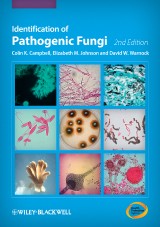Details

Identification of Pathogenic Fungi
2. Aufl.
|
127,99 € |
|
| Verlag: | Wiley-Blackwell |
| Format: | EPUB |
| Veröffentl.: | 25.01.2013 |
| ISBN/EAN: | 9781118520079 |
| Sprache: | englisch |
| Anzahl Seiten: | 352 |
DRM-geschütztes eBook, Sie benötigen z.B. Adobe Digital Editions und eine Adobe ID zum Lesen.
Beschreibungen
<p>Since the first edition of <i>Identification of Pathogenic Fungi</i>, there has been incredible progress in the diagnosis, treatment and prevention of fungal diseases: new methods of diagnosis have been introduced, and new antifungal agents have been licensed for use. However, these developments have been offset by the emergence of resistance to several classes of drugs, and an increase in infections caused by fungi with innate resistance to one or more classes.</p> <p><i>Identification of Pathogenic Fungi</i>, Second Edition, assists in the identification of over 100 of the most significant organisms of medical importance. Each chapter is arranged so that the descriptions for similar organisms may be found on adjacent pages. Differential diagnosis details are given for each organism on the basis of both colonial appearance and microscopic characteristics for the organisms described.</p> <p>In this fully updated second edition, a new chapter on the identification of fungi in histopathological sections and smears has been added, while colour illustrations of cultures and microscopic structures have been included, and high quality, four colour digital images are incorporated throughout.</p>
<p>Preface, ix</p> <p>Acknowledgements, xi</p> <p><b>1 Introduction, 1</b></p> <p><b>2 Identification of Moulds, 11</b></p> <p>Media for Mould Identification, 14</p> <p>Mounting Fluids, 16</p> <p><b>3 Moulds with Arthrospores, 18</b></p> <p>Neoscytalidium dimidiatum, 20</p> <p>Coccidioides species, 24</p> <p>Onychocola canadensis, 28</p> <p><b>4 Moulds with Aleuriospores: I. The Dermatophytes, 31</b></p> <p>Microsporum gypseum, 38</p> <p>Microsporum canis, 40</p> <p>Microsporum equinum, 42</p> <p>Epidermophyton floccosum, 44</p> <p>Trichophyton terrestre, 46</p> <p>Trichophyton rubrum, 48</p> <p>Trichophyton interdigitale, 52</p> <p>Trichophyton mentagrophytes, 54</p> <p>Trichophyton erinacei, 56</p> <p>Trichophyton equinum, 58</p> <p>Trichophyton soudanense, 60</p> <p>Microsporum persicolor, 62</p> <p>Trichophyton tonsurans, 64</p> <p>Microsporum audouinii, 66</p> <p>Trichophyton violaceum, 68</p> <p>Trichophyton verrucosum, 70</p> <p>Trichophyton schoenleinii, 72</p> <p>Trichophyton concentricum, 74</p> <p>Other Microsporum and Trichophyton species, 76</p> <p><b>5 Moulds with Aleuriospores: II. Others, 80</b></p> <p>Geomyces pannorum, 82</p> <p>Chrysosporium keratinophilum, 84</p> <p>Myceliophthora thermophila, 86</p> <p>Histoplasma capsulatum, 88</p> <p>Blastomyces dermatitidis, 92</p> <p>Paracoccidiodes brasiliensis, 96</p> <p><b>6 Moulds with Holoblastic Conidia, 99</b></p> <p>Aureobasidium pullulans, 102</p> <p>Sporothrix schenckii, 104</p> <p>Cladophialophora bantiana, 106</p> <p>Cladosporium sphaerospermum, 108</p> <p>Fonsecaea pedrosoi, 110</p> <p>Rhinocladiella atrovirens, 112</p> <p>Rhinocladiella mackenziei, 114</p> <p>Ochroconis gallopava, 116</p> <p>Alternaria alternata, 118</p> <p>Ulocladium chartarum, 120</p> <p>Curvularia lunata, 122</p> <p>Bipolaris hawaiiensis, 124</p> <p>Exserohilum rostratum, 126</p> <p><b>7 Moulds with Enteroblastic Conidia Adhering in Chains, 129</b></p> <p>Aspergillus flavus species complex, 134</p> <p>Aspergillus fumigatus species complex, 136</p> <p>Aspergillus glaucus, 138</p> <p>Aspergillus nidulans species complex, 140</p> <p>Aspergillus versicolor species complex, 142</p> <p>Aspergillus ustus species complex, 144</p> <p>Aspergillus niger species complex, 146</p> <p>Aspergillus terreus species complex, 148</p> <p>Aspergillus candidus species complex, 150</p> <p>Penicillium marneffei, 152</p> <p>Scopulariopsis brevicaulis, 154</p> <p>Purpureocillium lilacinum, 156</p> <p>Paecilomyces variotii, 158</p> <p><b>8 Moulds with Enteroblastic Conidia Adhering in Wet Masses, 161</b></p> <p>Fusarium lichenicola, 166</p> <p>Fusarium dimerum species complex, 168</p> <p>Fusarium semitectum, 170</p> <p>Fusarium proliferatum, 172</p> <p>Fusarium oxysporum species complex, 174</p> <p>Fusarium solani species complex, 176</p> <p>Acremonium strictum, 178</p> <p>Acremonium kiliense, 180</p> <p>Lecythophora mutabilis, 182</p> <p>Scedosporium prolificans, 184</p> <p>Scedosporium apiospermum, 186</p> <p>Phaeoacremonium parasiticum, 188</p> <p>Pleurostomophora richardsiae, 190</p> <p>Phialophora verrucosa, 192</p> <p>Hortaea werneckii, 194</p> <p>Exophiala spinifera, 196</p> <p>Exophiala dermatitidis, 198</p> <p>Exophiala jeanselmei, 200</p> <p><b>9 Mucoraceous Moulds and Their Relatives, 203</b></p> <p>Cunninghamella bertholletiae, 208</p> <p>Lichtheimia corymbifera, 210</p> <p>Rhizomucor pusillus, 212</p> <p>Mucor circinelloides, 214</p> <p>Rhizopus microsporus, 216</p> <p>Rhizopus arrhizus, 218</p> <p>Mucor hiemalis, 220</p> <p>Basidiobolus ranarum, 222</p> <p>Conidiobolus coronatus, 224</p> <p>Pythium insidiosum, 226</p> <p>Apophysomyces elegans, 228</p> <p>Saksenaea vasiformis, 230</p> <p>Mortierella wolfii, 232</p> <p><b>10 Miscellaneous Moulds, 235</b></p> <p>Aphanoascus fulvescens, 238</p> <p>Monascus ruber, 240</p> <p>Chaetomium species, 242</p> <p>Phoma herbarum, 244</p> <p>Myxotrichum deflexum, 246</p> <p>Schizophyllum commune, 248</p> <p>Leptosphaeria senegalensis, 250</p> <p>Neotestudina rosatii, 252</p> <p>Piedraia hortae, 254</p> <p>Lasiodiplodia theobromae, 256</p> <p>Pyrenochaeta romeroi, 258</p> <p>Madurella mycetomatis, 260</p> <p><b>11 Identification of Yeasts, 263</b></p> <p>Media for Yeast Identification, 272</p> <p>Candida albicans, 274</p> <p>Candida tropicalis, 276</p> <p>Candida krusei, 278</p> <p>Candida lipolytica, 280</p> <p>Candida kefyr, 281</p> <p>Candida lusitaniae, 282</p> <p>Candida parapsilosis, 284</p> <p>Candida pelliculosa, 286</p> <p>Candida guilliermondii, 287</p> <p>Candida glabrata, 288</p> <p>Cryptococcus neoformans and Cryptococcus gattii, 290</p> <p>Rhodotorula glutinis, 292</p> <p>Saccharomyces cerevisiae, 294</p> <p>Geotrichum candidum, 296</p> <p>Saprochaete capitata, 298</p> <p>Trichosporon species, 300</p> <p>Malassezia furfur species complex, 302</p> <p>Malassezia pachydermatis, 304</p> <p><b>12 Identification of Fungi in Sections, Smears and Body Fluids, 305</b></p> <p>Appendix 1: Common Mycological Terms, 321</p> <p>Appendix 2: Further Reading, 325</p> <p>Species Index, 327</p> <p>Subject Index, 333</p>
<p>“Clinicians, microbiology laboratory personnel, and students will all find this reference source valuable.” (<i>Clinical Infectious Diseases</i>, 22 August 2014)</p> <p> </p> <p> </p>
<p><b>Colin K. Campbell</b>, Health Protection Agency Mycology Reference Laboratory, Bristol, UK (retired)</p> <p><b>Elizabeth M. Johnson</b>, Health Protection Agency Mycology Reference Laboratory, Bristol, UK</p> <p><b>David W. Warnock</b>, National Center for Emerging and Zoonotic Infectious Diseases, Centers for Disease Control and Prevention, Atlanta, GA, USA</p>
<p>Since the first edition of <i>Identification of Pathogenic Fungi</i>, there has been incredible progress in the diagnosis, treatment and prevention of fungal diseases: new methods of diagnosis have been introduced, and new antifungal agents have been licensed for use. However, these developments have been offset by the emergence of resistance to several classes of drugs, and an increase in infections caused by fungi with innate resistance to one or more classes.</p> <p><i>Identification of Pathogenic Fungi</i>, Second Edition, assists in the identification of over 100 of the most significant organisms of medical importance. Each chapter is arranged so that the descriptions for similar organisms may be found on adjacent pages. Differential diagnosis details are given for each organism on the basis of both colonial appearance and microscopic characteristics for the organisms described.</p> <p>In this fully updated second edition, a new chapter on the identification of fungi in histopathological sections and smears has been added, while colour illustrations of cultures and microscopic structures have been included, and high quality, four colour digital images are incorporated throughout.</p>


















